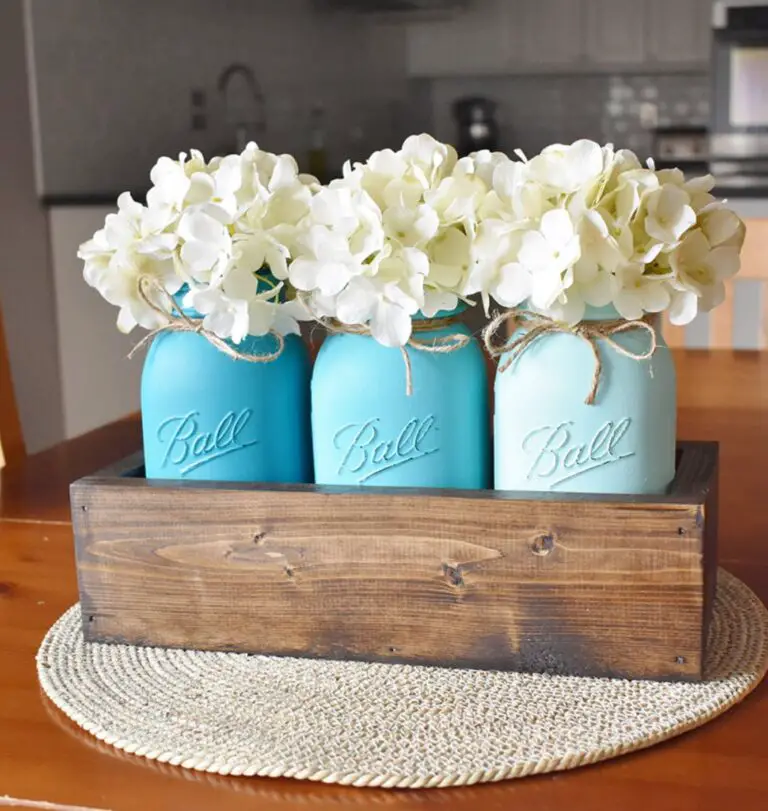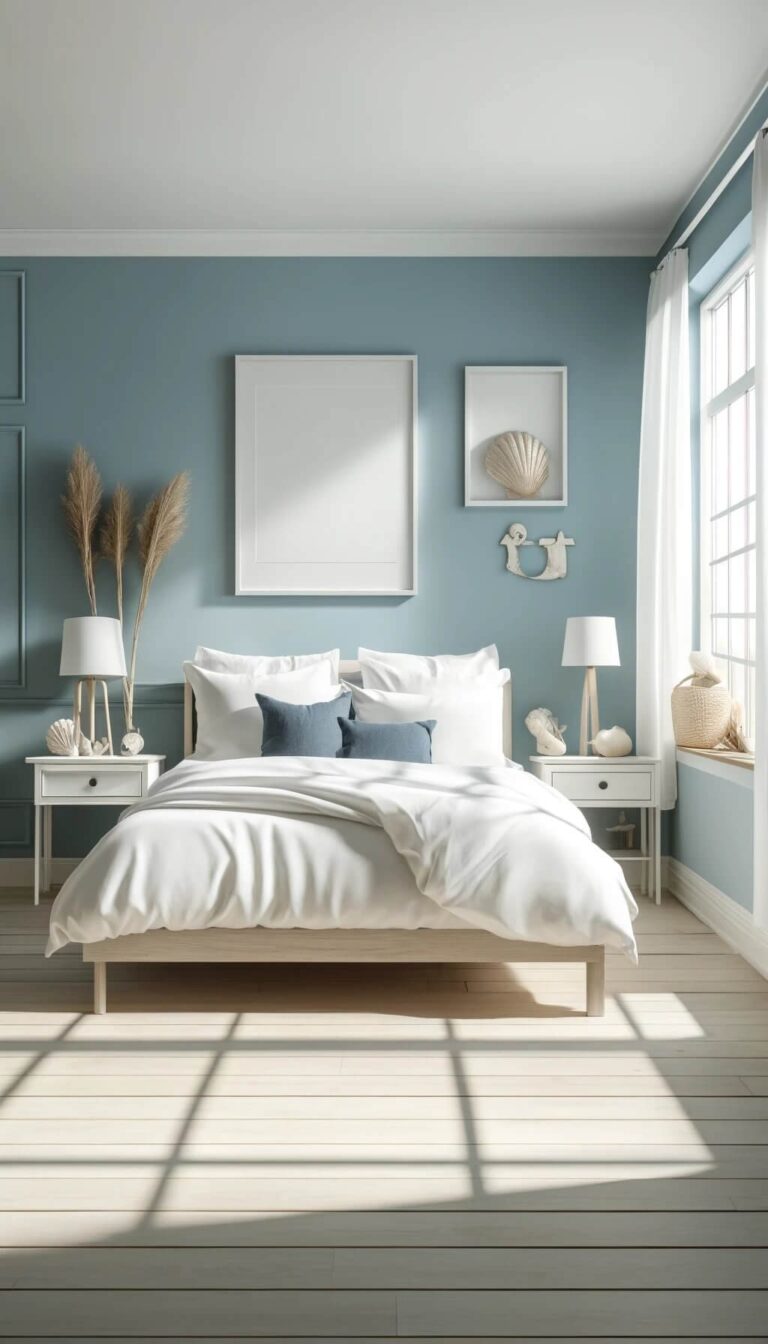12 Best Drop Ceiling Alternatives: Stylish And Affordable Solutions
If you’re looking for ways to refresh your home’s interior without incurring significant costs, exploring alternative options to traditional drop ceilings can be an excellent starting point. With numerous styles and materials available, you can find a solution that suits your taste, budget, and functional requirements.
In this article, we’ll delve into the world of drop ceiling alternatives, highlighting their pros and cons, and providing valuable insights to help you make an informed decision. Whether you’re seeking to revamp your living space or merely looking for cost-effective solutions, our comprehensive guide will equip you with the knowledge necessary to choose the perfect alternative for your needs.
From acoustic tiles to wooden planks, we’ll examine 12 popular alternatives, exploring their advantages and disadvantages. This exhaustive review will enable you to weigh the pros and cons of each option, ultimately empowering you to select the most suitable solution for your home renovation project.
Acoustic Tiles
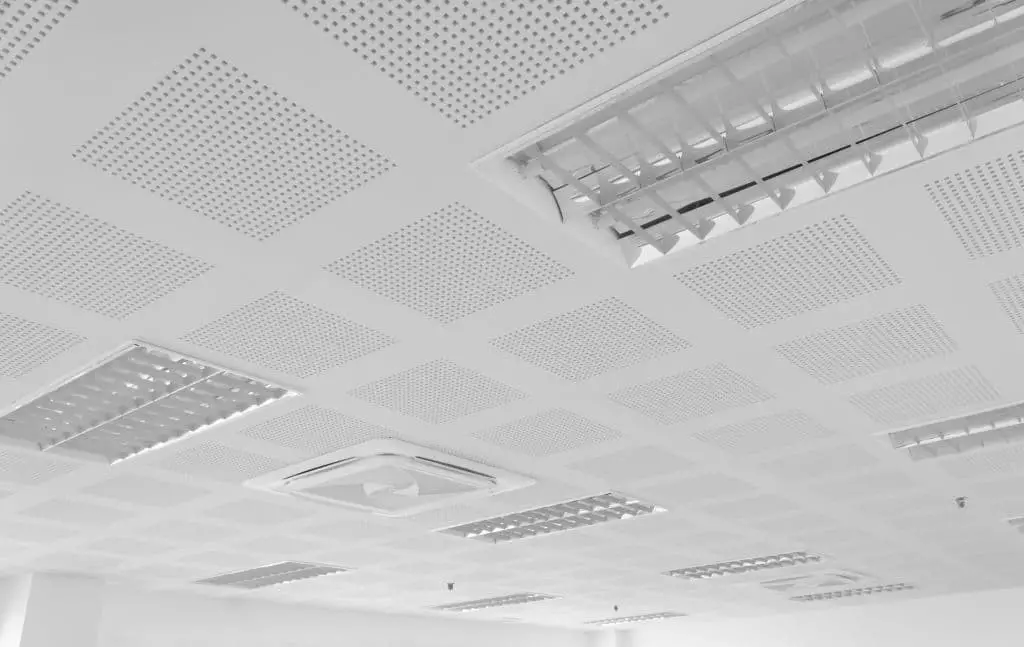
When it comes to finding an effective alternative to traditional drop ceilings, acoustic tiles are definitely worth considering. Not only do they offer a range of colors and styles to suit any space, but they also provide a solution for reducing noise levels – making them a top choice for busy areas. What’s more, acoustic tiles are an affordable and straightforward installation option.
If you’re looking for a stylish and functional alternative that ticks all the right boxes, acoustic tiles could be just what you need.
Cons of using Acoustic tiles:
While drop ceilings can offer a range of benefits, it’s essential to consider their limitations. One potential drawback is that they may not be as durable as other alternatives on the market. This can be a concern for building owners and facility managers who need to ensure that their ceiling systems will withstand the test of time. Additionally, drop ceilings can be challenging to clean if they become dirty or stained.
This can lead to issues with aesthetics and potentially even impact indoor air quality.
Beadboard
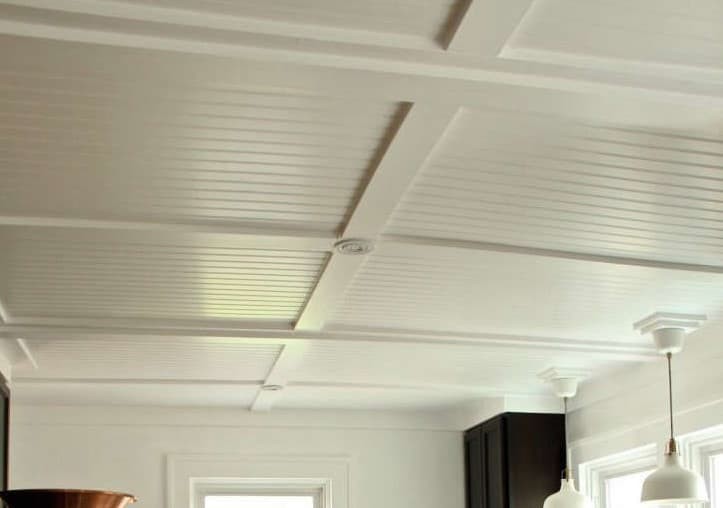
When considering alternatives to traditional drop ceilings, beadboard is a stylish and versatile option worth exploring. This decorative material offers an attractive appearance that can create the illusion of higher ceilings, making it a great choice for homeowners seeking to enhance their room’s visual appeal.
One of its key advantages is its flexibility – you can easily paint beadboards in any color that complements your existing décor, allowing for seamless integration into your home’s design.
Cons of using Beadboard:
While beadboard ceilings have their unique charm, they do come with some limitations. For instance, they may not be as durable as drop ceilings and can be a challenge to clean due to the airtight seal between tiles and panels. This can lead to issues like mold buildup, which can exacerbate health problems for individuals with allergies or asthma. Additionally, beadboard is not fire-resistant, making it less suitable for spaces that require this critical safety feature.
Despite these drawbacks, beadboard ceilings can still be an attractive option when paired with a thoughtful design and proper maintenance.
Ceiling Tiles
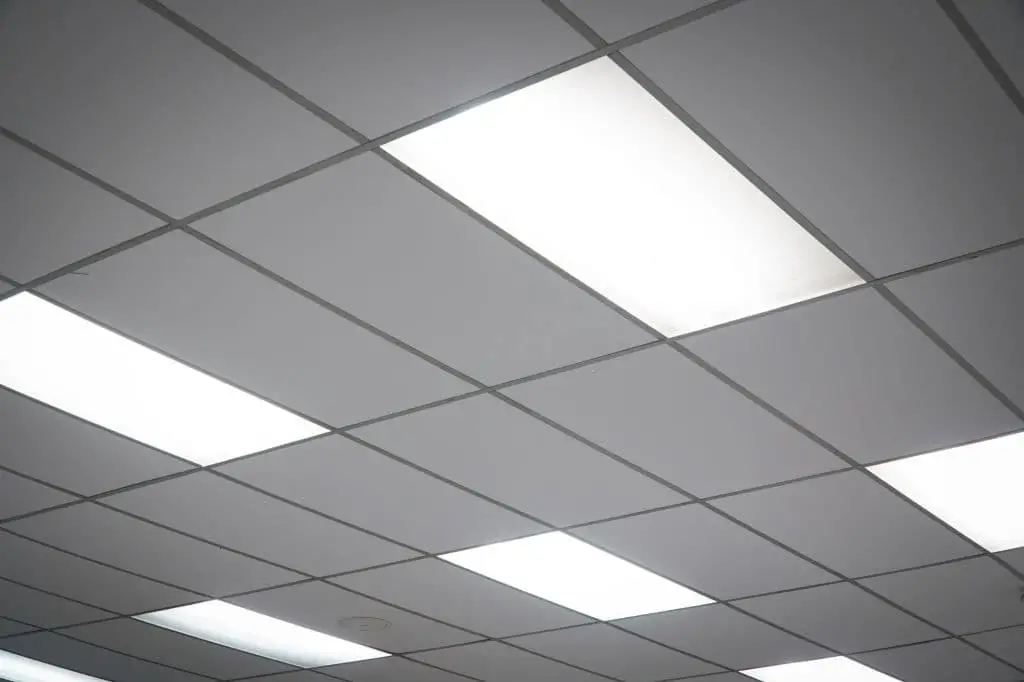
Ceiling tiles are a versatile alternative to traditional drop ceilings. With numerous styles and colors to choose from, you can find a perfect match for your space. However, it’s crucial to consider the level of opacity when selecting tiles, as those with low natural light may require more opaque options. While ceiling tiles offer many benefits, they also come with some drawbacks. For instance, installation might be challenging if you’re not experienced in this type of work.
Additionally, cleaning can be a hassle if the tiles become stained or dirty. Furthermore, some ceiling tiles may release high levels of VOCs (volatile organic compounds), which can exacerbate allergies and asthma. Another consideration is fire resistance. Since ceiling tiles are not inherently fire-resistant, they might not be suitable for spaces requiring this safety feature.
Moreover, these tiles may not be as durable as drop ceilings and will eventually require replacement, depending on usage frequency, intensity, and the type of material used. Lastly, ceiling tiles can be a significant investment, with prices varying greatly based on style and quality. While they do offer a unique aesthetic, they might also limit natural light entering the room, which is an essential factor to consider when evaluating alternatives.
Corrugated Metal
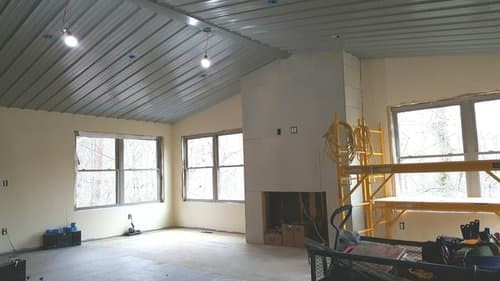
For those seeking a budget-friendly and visually appealing replacement for traditional drop ceilings, corrugated metal is an excellent option. Not only does it offer superior durability, but its versatility in terms of paint color also allows you to seamlessly integrate it with your existing décor. Moreover, the unique texture it brings to a room can greatly enhance its overall aesthetic appeal.
Cons of using Corrugated Metal:
While solar panels are a fantastic way to generate clean energy, it’s essential to consider their potential drawbacks. For instance, they might not be the best fit for every environment due to their industrial appearance, which could detract from the aesthetic appeal of certain spaces. Furthermore, if not properly insulated, solar panels can also produce noise that may disturb those around them.
PVC panels
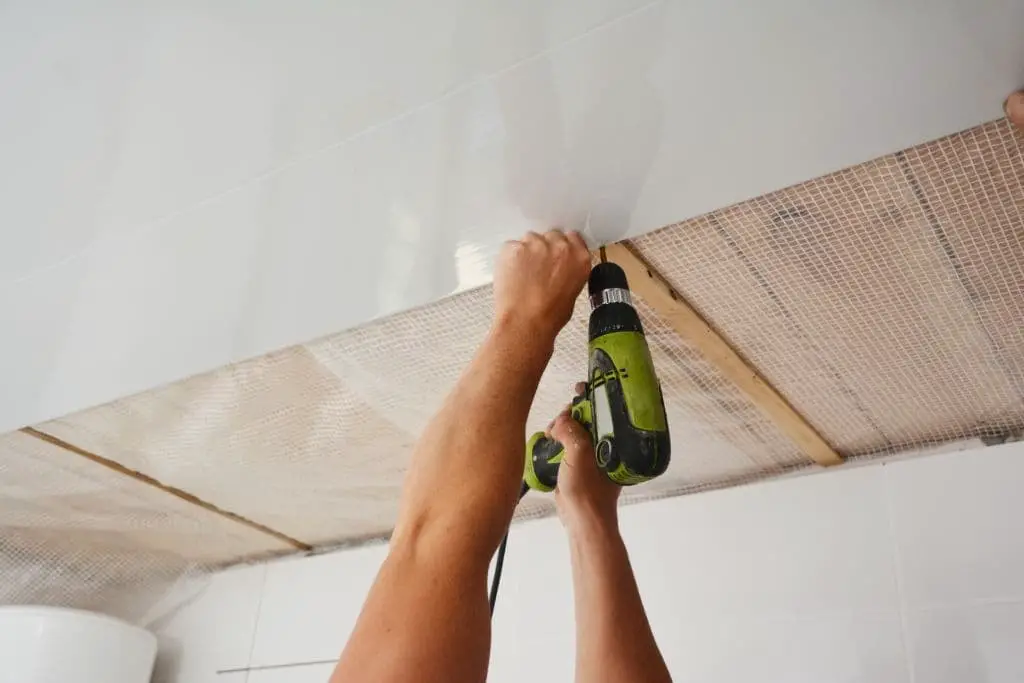
For those seeking an alternative to traditional drop ceilings, PVC panels offer a convenient and adaptable solution. Not only do they boast an effortless installation process, but they can also be effortlessly painted to seamlessly blend with any given décor. Furthermore, PVC panels provide the added benefit of being completely resistant to rust and staining, setting them apart from other materials that may compromise on these fronts.
Cons of using PVC panels:
While solar panels are generally a reliable and efficient source of renewable energy, there are some potential drawbacks to consider. For instance, if they’re not installed correctly, the panels themselves may become damaged or even crack over time. Additionally, if proper insulation isn’t implemented, the equipment can generate unwanted noise levels, potentially disrupting the surrounding environment.
Drywall
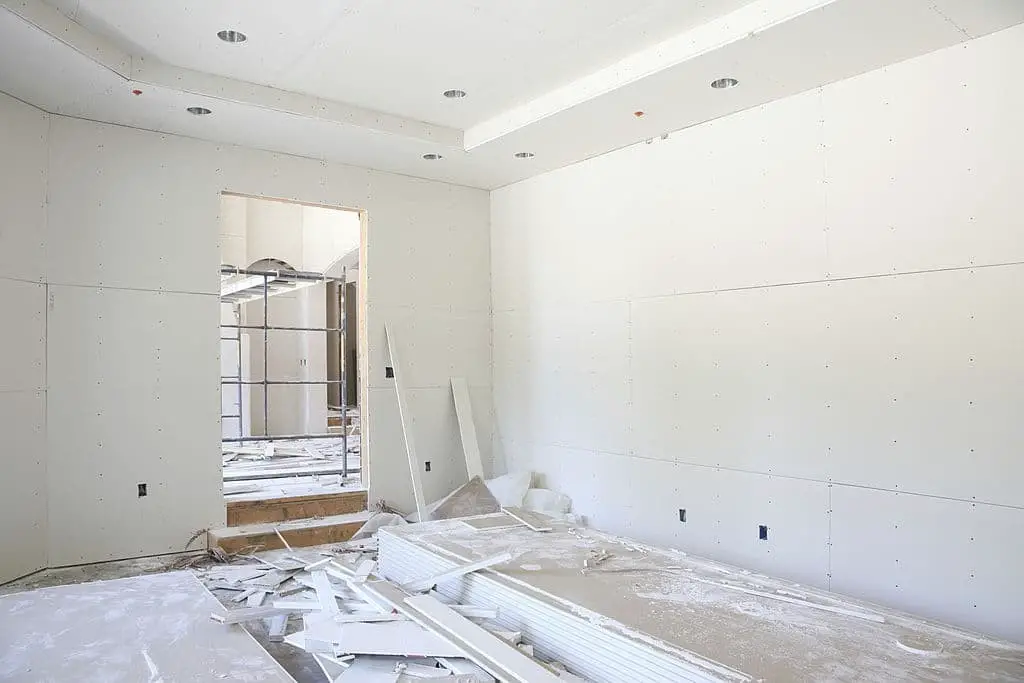
Looking for an alternative to the classic drop ceiling? Drywall might be the answer you’re looking for. Not only is it an affordable option, but it’s also easily paintable to blend seamlessly with your existing décor. Plus, installing drywall can provide a welcome boost of insulation in any room, making it a practical choice for those seeking to keep their space cozy and energy-efficient.
Pros of using Drywall:
This innovative product offers numerous benefits for homeowners, including the ability to install it themselves. One of its most attractive features is the wide range of textures and colors available, allowing users to choose a style that perfectly matches their unique taste. Furthermore, this product provides exceptional insulation properties, effectively keeping rooms warm in the winter and cool in the summer.
Cons of using Drywall:
While drywall has its advantages, it’s essential to consider its limitations. One key drawback is that it may not be as durable as other materials, potentially leading to scratches or cracks over time. Additionally, installing drywall can be a challenging process if you’re new to DIY projects. The visual appeal of drywall can also be compromised if the joints are not properly finished, leaving an unsightly finish.
Furthermore, if drywall is not insulated adequately, it can produce unwanted noise levels, disrupting the overall ambiance of your space.
Faux Wooden Beams

A stylish and budget-friendly option for replacing traditional drop ceilings is faux wooden beams. These versatile beams can be crafted from wood, medium-density fiberboard (MDF), or plastic, offering a range of materials to suit any design aesthetic. Typically installed in a grid pattern similar to traditional ceilings, faux wooden beams come in various sizes and styles to seamlessly integrate with your room’s décor.
Not only do they add a touch of elegance and personality to the space, but they’re also often more affordable than many other alternatives.
Pros of using Faux Wooden Beams:
Versatility is one of the key advantages of drop ceilings. Not only can they be created using various materials, but also come in a range of styles to ensure a seamless fit with any existing décor. Furthermore, compared to many other available options, drop ceilings are often more budget-friendly, making them an attractive choice for those looking to add some finishing touches to their space without breaking the bank.
Cons of using Faux Wooden Beams:
While some designs may not perfectly replicate the natural appearance of wooden beams with drop ceilings, this largely hinges on the chosen aesthetic and installation method. However, what’s undeniable is that wooden beams can pose a challenge when it comes to proper and secure installation – a task that becomes even more daunting for DIY enthusiasts.
Plywood ceiling
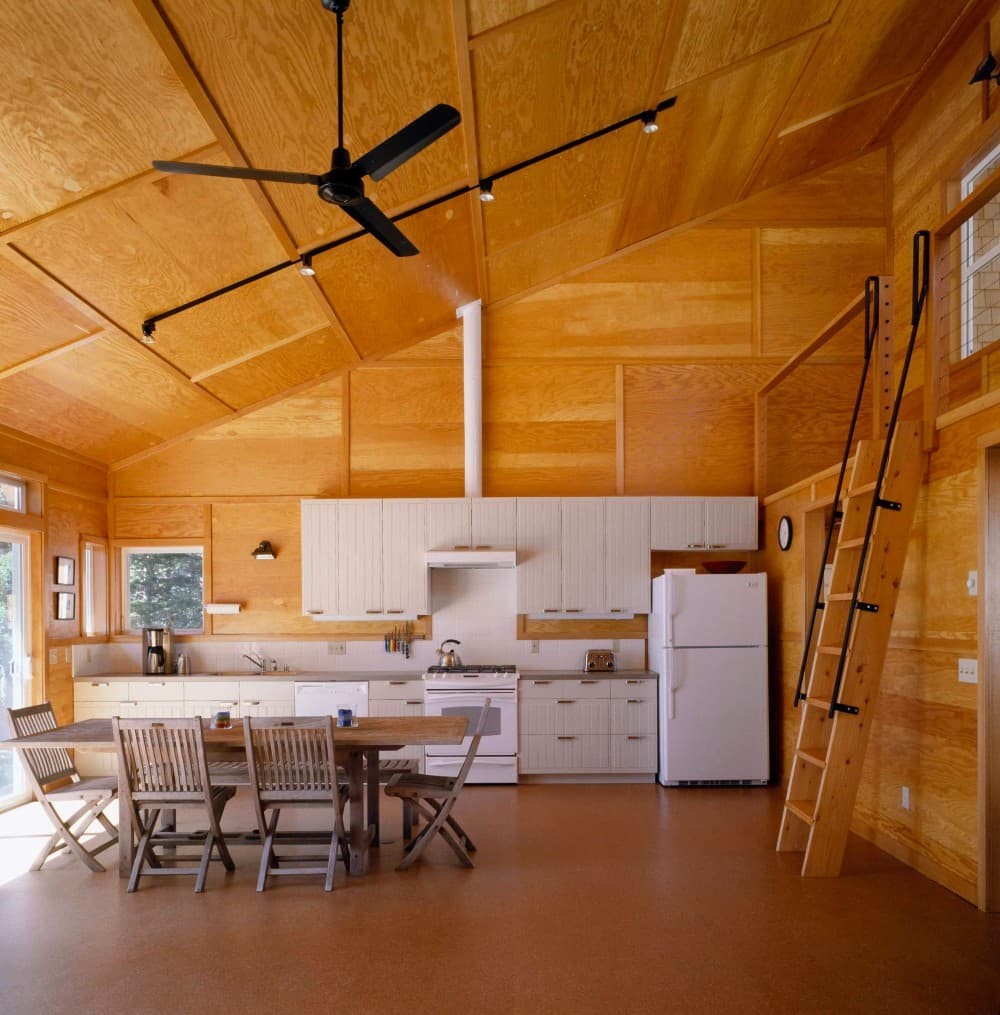
When considering alternatives to traditional drop ceilings, plywood ceilings are an option worth exploring. This material is notable for its affordability and durability, making it a practical choice for many homeowners. The versatility of plywood allows it to be stained or painted to seamlessly blend with any décor, lending itself well to creating a unique and rustic ambiance in a room. Additionally, the installation process is relatively straightforward, even for DIY enthusiasts.
Pros of using Plywood Ceilings:
One of the key benefits of [insert type of material here] is its affordability, making it a practical choice for those looking to upgrade their space without breaking the bank. Additionally, its durability ensures that your investment will last for years to come, withstanding wear and tear without compromising its appearance.
Furthermore, this versatile material can be easily stained or painted to seamlessly integrate with any décor, allowing you to express your personal style without worrying about limitations.
Cons of using Plywood Ceilings:
Drop ceilings, while often overlooked, can be a viable option for homeowners looking to conceal ductwork or create a sense of openness in a room. However, it’s essential to consider the potential drawbacks before making a decision. For instance, drop ceilings may not boast the same level of visual appeal as other alternatives. Additionally, installation can be a complex process, especially for those without experience with carpentry.
Furthermore, these ceilings might require more maintenance and upkeep over time to maintain their appearance. Despite these limitations, drop ceilings can still be a practical choice for certain projects.
Stained Glass Ceilings
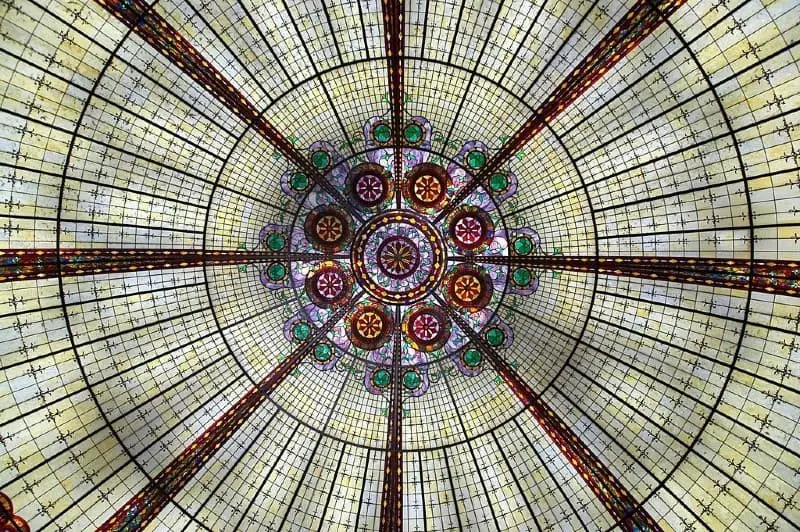
A stylish alternative to traditional drop ceilings, stained glass ceilings offer a unique and versatile solution for homeowners seeking to elevate their interior design. With a vast range of color options and designs available, you can effortlessly find a stain glass ceiling that harmonizes with your space’s aesthetic.
Moreover, these innovative fixtures are not only budget-friendly but also relatively easy to install, making them an attractive option for those looking to revamp their home’s ambiance.
Pros of using Stained Glass Ceilings:
Elevate the ambiance of your space by incorporating this versatile design element, which effortlessly injects personality and charm into any room. With a wide range of colors and styles available, you’re sure to find a perfect match for your unique aesthetic. What’s more, these designs are not only visually appealing but also budget-friendly and relatively simple to install, making them an ideal addition to any home.
Cons of using Stained Glass Ceilings:
Some surfaces may pose unique challenges, such as being too busy for thorough cleaning or requiring more effort to maintain their appearance. Additionally, certain materials can be notoriously difficult to clean if they become soiled with substances that are stubbornly stuck on them.
Tin ceiling
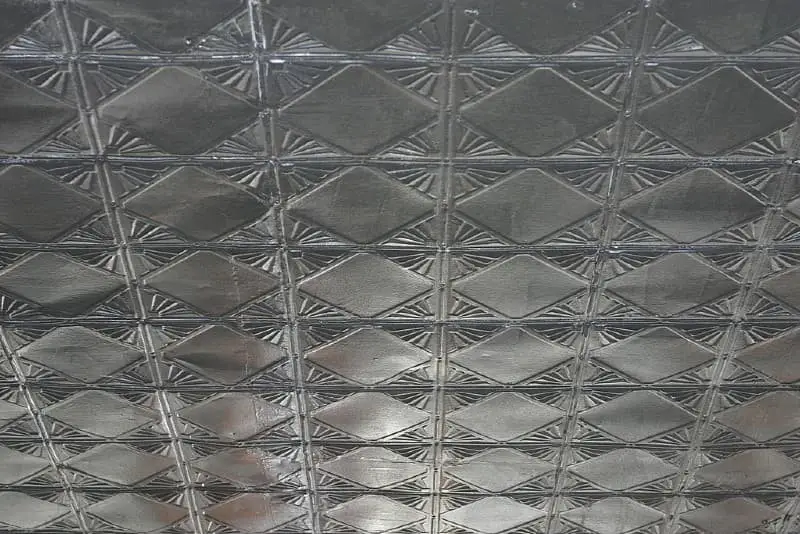
Looking for a budget-friendly yet stylish replacement for traditional drop ceilings? Look no further than tin ceilings, a popular choice since the early 20th century that continues to captivate homeowners today. One of the key advantages of tin ceilings is their durability – resistant to dents and corrosion, making them an ideal material for this application.
What’s more, tin ceilings come in a diverse range of colors and styles, allowing you to seamlessly integrate them into your existing décor. However, it’s essential to note that installing a tin ceiling requires the expertise of a qualified contractor, as special installation techniques and tools are necessary. Leave the heavy lifting to the professionals and enjoy the benefits of a beautifully executed tin ceiling in your home.
Cons of using tin ceiling:
Wooden Planks
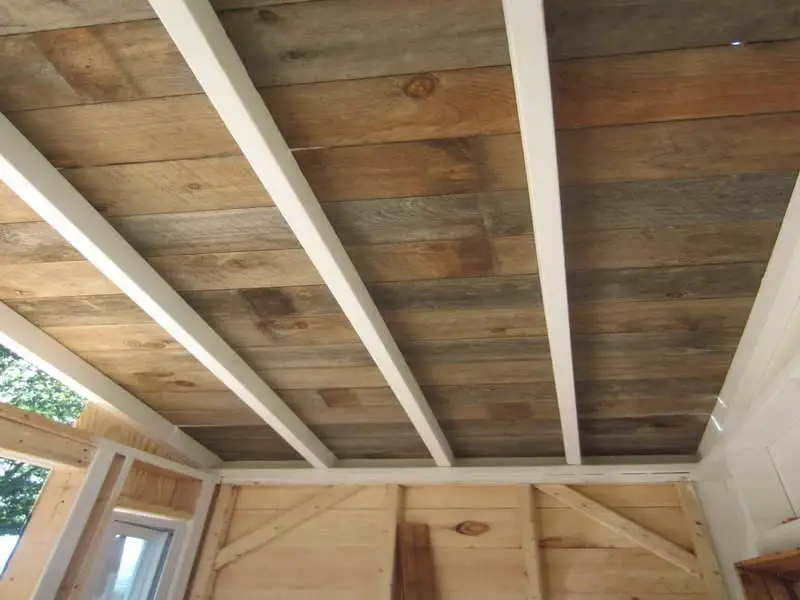
Wooden planks offer a stylish alternative to traditional drop ceilings. To achieve this look, tongue and groove boards or shiplap panels are installed directly onto the joists above. This rustic design not only adds visual appeal but also provides an affordable option for homeowners. It’s essential to use a high-quality finish like paint or sealant to protect the wood from moisture and potential damage over time.
Cons of using wooden planks:
When it comes to installing wooden planks as a ceiling material, homeowners must consider several key factors. Firstly, additional insulation is crucial in the attic space above, as there is no drop ceiling to protect against heat loss or gain. This requires careful planning and execution to ensure optimal energy efficiency. Another important consideration is cost. While wooden planks may be more expensive than drywall upfront, the installation process can also add to the overall expense.
DIY enthusiasts should expect to invest time and specialized tools in the project, which may not be feasible for all homeowners. Professional installations, on the other hand, can result in higher costs compared to drop ceilings. Furthermore, wooden planks present challenges when it comes to future maintenance or repairs. The lack of an easy access panel like those found with drop ceilings means that accessing pipes and wires can be more complicated and time-consuming.
This may lead to increased labor costs or even require additional renovation work if issues arise. Finally, the wooden ceiling itself is not immune to damage from moisture-related incidents, such as leaks or spills. While these events are rare, they do pose a risk of costly repairs down the line, making it essential for homeowners to carefully consider the potential long-term consequences of their choice.
Fiberglass panels

When searching for a stylish and budget-friendly alternative to traditional drop ceilings, fiberglass panels are definitely worth considering. These durable panels can be painted to perfectly match your desired aesthetic, and they also possess impressive insulating properties that can help minimize energy costs. For successful installation, you’ll need to acquire drop ceiling grid clips that enable the panels to hang seamlessly from the frame.
You have two primary options for installing fiberglass panels: a drop-in approach or an overlay method, which involves attaching them directly to your existing drywall.
Cons of using fiberglass panels:
Installing and designing drop ceilings can present unique challenges. For those who aren’t experienced with DIY projects, the installation process may prove more complicated than anticipated. Furthermore, some individuals might be deterred by the aesthetic aspect of drop ceilings, which can create an illusion that their rooms are smaller than they truly are.
Pros of using fiberglass panels:
One of the most attractive aspects of drop ceiling panels is their cost-effectiveness. In comparison to other alternatives, such as wood or tin, they offer a more affordable solution. Furthermore, these panels are remarkably easy to clean and maintain, reducing the risk of mold and mildew growth that can occur with other options over time.
What’s more, installing these panels doesn’t require extensive DIY expertise – even those without significant handyman experience can successfully complete the installation process with minimal hassle.
FAQs
What is the cheapest ceiling option?
One of the most budget-friendly options for ceilings is a drop ceiling, which consists of a grid of metal or plastic panels suspended from the joists. The panels are then filled with insulation and topped with drywall. This type of ceiling is relatively straightforward to install and offers an affordable solution. While it’s an effective choice, some may find that drop ceilings can appear somewhat outdated in their aesthetic.
Is it cheaper to drywall or drop ceiling?
While a drywalled ceiling may be a more budget-friendly option compared to installing a traditional drop ceiling, it’s essential to consider various factors that influence the overall cost. As such, it’s highly recommended to obtain a quote from a qualified contractor before making an informed decision.
What are some of the pros and cons of drop ceiling alternatives?
Drop ceiling alternatives offer a range of benefits, including ease of installation, affordability, and versatility in terms of style and material options. However, it’s essential to consider the potential drawbacks, such as the possibility of dated appearance, limited suitability for certain rooms or spaces, and challenges related to cleaning and maintenance.
How much does it cost to replace a dropped ceiling?
The costs of drop ceiling alternatives fluctuate significantly depending on the material chosen. A popular alternative is drywall, which typically costs $0.50 per square foot for installation. In contrast, plastic or metal panels can range from $0.75 to over $100 per panel, excluding materials and labor costs. When considering a replacement, it’s essential to obtain quotes from contractors to factor in the total cost of the project.
Can you replace a drop ceiling with drywall?
While utilizing drywall as a material for drop ceiling alternatives is feasible, it’s crucial to recognize that you’ll need to bring in a professional, such as an electrician or contractor, to facilitate the installation. Their expertise will be instrumental in ensuring that wires are properly routed through the joists and securely attached to studs within your home’s walls, typically speaking.
Why do older homes have drop ceilings?
Older homes frequently feature drop ceilings due to their affordability and ease of installation. Their lightweight nature also makes them an attractive solution for older properties that may lack the structural integrity of newer constructions. Moreover, drop ceilings can be installed incrementally, allowing homeowners to start with a single room or section and add more areas later on. This flexibility is particularly beneficial for those working within budget constraints.
Conclusion
As we’ve explored various drop ceiling alternatives, it’s clear that each has its unique characteristics and applications. With this newfound understanding, readers are now equipped to make a more informed decision regarding which solution best suits their specific space – whether that be residential or commercial. For any remaining questions or concerns, feel free to reach out to our team of experts.
We’re always here to provide additional guidance, offering personalized recommendations tailored to your unique needs and goals.
Related Posts
Elevate your living space’s aesthetic appeal by transforming a rattan dresser into a showstopping piece. To achieve this, explore unconventional styling approaches that marry pattern and color play. For instance, consider juxtaposing bold, graphic prints against soft, muted hues or pairing geometric patterns with organic textures. This harmonious blend will inject a touch of glamour into your home décor.
Furthermore, discover innovative ways to incorporate retro-inspired rugs into your interior design, ensuring a cohesive visual narrative that seamlessly merges past and present.


